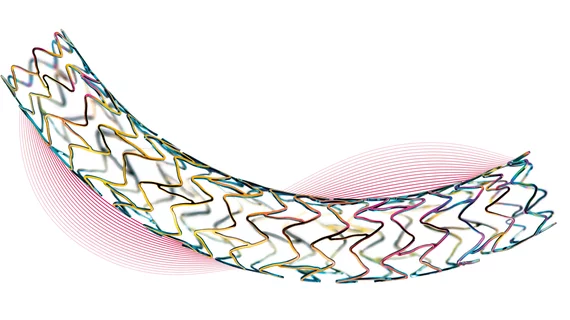TCT.18: BIONYX finds novel zotarolimus-eluting stent noninferior to Orsiro
Resolute Onyx, a polymer-coated zotarolimus-eluting stent, has been proven safe and effective in an all-comer population of more than 2,000 heart patients, according to late-breaking results of the BIONYX trial.
BIONYX, presented at this year’s Transcatheter Cardiovascular Therapeutics (TCT) meeting in San Diego, studied the efficacy of Resolute Onyx against the Orsiro stent, an established and ultrathin-strutted bioresorbable polymer-coated sirolimus-eluting stent that’s been proven safe and effective in a handful of randomized clinical trials. Lead investigator and interventional cardiologist Clemens von Birgelen, MD, PhD, said in a release his team developed Resolute Onyx in response to an increased demand for stents with better radiographic abilities.
“The vast majority of contemporary stents use stent platforms from cobalt-chromium alloy, which allows for the creation of fine mesh tubes with satisfactory radial force but limited x-ray visibility,” von Birgelen, also a professor at the University of Twente in Enschede, Netherlands, said. “Suboptimal radiographic visibility can be challenging in obese patients, when treating bifurcated or calcified coronary lesions or when carefully assessing stent expansion.”
The Resolute, then, was developed using a novel thin-strut composite wire stent platform, covered with a zotarolimus-eluting polymer coating. The metallic stent platform comprises a composite wire made from platinum-iridium core, making the struts radiopaque, and an outer layer of cobalt-chromium alloy. Von Birgelen said those tweaks could make for a stent that’s more easily recognizable in a patient’s body, especially if the stent has trouble expanding or isn’t completely apposed to the arterial wall.
Von Birgelen and his team included a total of 2,488 all-comer patients in their analysis, the majority of whom were men and presented to the hospital with an acute coronary syndrome. Of the pool, all between 30 and 96 years old, more than half were treated for acute MI.
The researchers found similar results among patients, regardless of whether they were randomized to receive the Resolute Onyx or Orsiro stent. After a year of follow-up, 4.5 percent of patients assigned to Resolute Onyx met the primary endpoint of target vessel failure, while 4.7 percent met the primary endpoint in the Orsiro group. Rates of cardiac death, target vessel-related MI and clinically indicated target revascularization were low in both groups, and 10 patients total experienced definite or probable stent thrombosis over the course of study.
Von Birgelen et al. were able to establish noninferiority of Resolute Onyx versus Orsiro with an absolute risk difference of -0.2 percent.
“Despite the difference in stent strut materials and thicknesses and the dissimilar durable and bioresorbable polymer coatings of the two study stents, the BIONYX study found no advantage for one stent over the other,” von Birgelen said. “Treatment with both stents was similarly safe and effective, with excellent one-year clinical outcomes in a complex all-comer patient population.”
He said the low stent thrombosis rate in Resolute Onyx “warrants further clinical investigation.”
Results of the BIONYX study were published in the Lancet Sept. 22.

